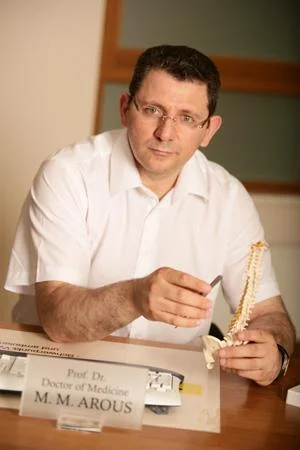PROF. DR. MED, MD, PHD MOHAMMAD MOULHEM AROUS
Prof Mohammad M. Arous, son of Syrian parents, was born in Hanover and began his career after completing his medical studies as a doctor of medicine (MD) at the University of Vitebsk in Belarus in 1992.
With his habilitation, he continued his academic career at the University of Minsk as a private lecturer, where he was awarded the doctorate (PhD) with scientific teaching license (Venia Legendi), and finally acquired the doctorate in medicine (Dr. med.) at the Medical University in Hanover.
In 1999 he gained recognition as a specialist in neurosurgery, followed by an additional qualification in pain therapy.
In 2003 he was appointed to a chair in the field of “minimally invasive therapy of the spine” at the Medical University of Haybusak/Yerevan (Armenia), with a regular appointment as a professor (Prof.) for life.
Thanks to his knowledge of four languages, in the period from 2003 to date there have been several stays abroad for training, further education (lectures and lectures) and for the training of medical colleagues and medical staff – including in Qatar, the United Arab Emirates (UAE) and in Syria, the Russian Federation, Armenia, Belarus and other countries.
After various medical management positions in German clinics, Prof. Arous now heads the specialist center for neurosurgery and special pain therapy he founded in Hamburg in 2004. In this specialist center, the author has helped numerous patients to recover and be free of pain thanks to his well-founded know-how and many years of therapeutic experience in minimally invasive methods. The author has applied for patents for the processes he has developed.
This work is a comprehensive professional overview of his expertise in the field of CT-guided laser thermonervation and is suitable for patients as well as for peers and experts.
Prof. M.D., Ph.D., M. M. Arous is a specialist in neurosurgery and pain therapy. In an interview, he discussed the neurosurgical treatment of intervertebral disc herniation, a common problem in Germany. The intervertebral disc herniation is caused by the protrusion of the disc’s nucleus through the annulus fibrosus, usually as a result of degenerative changes or wear and tear.
Neurosurgery is a surgical specialty that deals with treatments and surgeries of the central and peripheral nervous system, including brain and spinal cord injuries, tumors, intervertebral disc herniation, and spinal cord injuries. Pain therapy is often combined with neurosurgery.

There are various treatment options for intervertebral disc herniation, including conservative, minimally invasive, and surgical approaches. However, the trend has shifted towards minimally invasive therapies in recent years. There are several minimally invasive therapies, such as the X-ray-guided catheter therapy, CT-guided catheter therapy, laser therapy, and endoscopy.
The X-ray-guided catheter therapy involves a fine plastic tube that is inserted through a small incision to the damaged disc using X-ray control. The entire procedure takes only about 20 to 30 minutes, and during the operation, the inflamed tissue is flushed with a saline solution. Additionally, an enzyme-cortisone cocktail reduces swelling in the affected area. Unlike conventional surgery, there is no risk of recurrence due to scar formation. The patient can be discharged a few hours after the procedure and must return to the practice twice the following day for rinsing.
The catheter treatment significantly reduces pain by removing all accumulated waste products from the affected area, allowing the herniated disc to shrink and slowly return to its original position. As a result, the pressure on the nerves disappears, and the patient is relieved of pain.
In summary, Prof. M.D., Ph.D., M. M. Arous is an expert in neurosurgery and pain therapy. He explained the various treatments for intervertebral disc herniation, including the minimally invasive X-ray-guided catheter therapy, which is an effective and safe procedure that can relieve pain and prevent the recurrence of the problem.